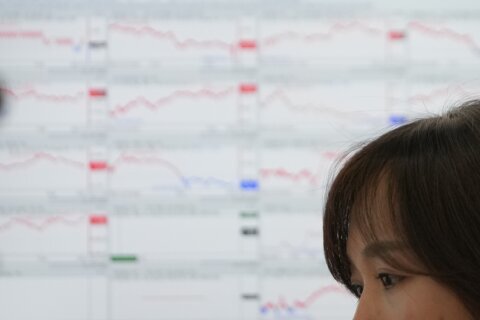WASHINGTON — We work with many women who are relatively new to investing and often want to know more about the investments that make up their portfolios.
With literally thousands of investments — from individual stocks like Google and Apple to bonds and mutual funds — the best way to know what to look for is to understand the basics of what the investment pros look for when investing.
To keep things a bit more simple, we will focus on mutual funds. There are certainly other appropriate investment vehicles that we use in building our clients’ portfolios, such as individually managed securities, exchange traded funds (ETFs), private real estate and equity deals. But overall, mutual funds make up the largest share of our clients’ portfolios and are what many investors are familiar with when investing their 401k or retirement accounts.
What is a mutual fund?
Simply put, mutual funds are professionally managed portfolios that pool money from multiple investors to buy shares of stocks, bonds or other securities. Each fund has different and well-defined investment objectives.
For instance, the managers of a fund may decide to focus on U.S. large-cap stocks, high-yield bonds or short-term debt. Each investor is a shareholder in the fund, and the fund’s total market value is the sum of all the underlying investments.
Individual stock (or bond, etc.) prices fluctuate throughout the day and can be bought and sold at any time during the day over exchanges, such as the New York Stock Exchange. Because mutual funds are made up of many securities with many values, trades must be made directly with the fund once per day after the market closes so that the prices of the securities that make up the fund can be calculated.
If you decide to sell shares in a mutual fund at any time during the day, your trade will be executed at the next available net asset value (NAV) after the market closes and can be higher or lower than the previous day’s closing NAV. Think of NAV as the book value or share price, which is just the total market value of the underlying portfolio holdings (less any liabilities) divided by the total number of shares.
Mutual fund pros and cons
The primary advantages of investing in a mutual fund are:
- diversification, because such funds invest in multiple securities, unlike owning a single stock;
- skilled professional management; and
- lower trading costs, because transaction costs are spread out over a large pool of shareholders and liquidity. (Most mutual funds have daily liquidity, and should you decide to sell, you can usually get your cash within three business days.)
Disadvantages typically relate to potential tax inefficiencies. Because you don’t control when the underlying investments are being sold, investors in a mutual fund may not be aware of capital gains triggered by sales until they receive a 1099 from the fund. This can make tax planning more difficult. There are also also the costs of creating, distributing and running a mutual fund that are passed on to investors.
Before diving in, know your investment goals
It goes without saying that before an investment adviser begins selecting mutual funds for a client’s portfolio, they sit down and discuss specific goals, risk tolerance, time horizon (the longer the better) and the importance of combining multiple asset classes to create a well-diversified portfolio.
Combining passive and actively managed mutual funds
There’s a lot of debate about whether it’s better to have an equity portfolio that is either
- passively managed, to track market indexes (such as the S&P 500) at a very low fee, or
- actively managed, to seek outperformance and greater flexibility (such as a specific emerging market or concentrated portfolio) at a higher fee.
We believe there’s room for both in a well-constructed portfolio. While passive indexing is best used to capture broad market returns, there are certain markets that are inefficient enough to create opportunities for outperformance by highly skilled managers. The challenge is finding an exceptional active manager who is able to outperform their benchmark over the long term.
How to analyze a mutual fund
There are several ways to obtain detailed information on most mutual funds.
You can go directly to the mutual fund’s website to pull a specific fund factsheet; use the research tools on your custodian’s website; or use an independent research firm such as Morningstar, which compiles and analyzes data for thousands of mutual funds.
At a minimum, you should review an updated fact sheet of your specific mutual fund to analyze different data metrics. Many investment advisers do extensive due diligence, including regular calls with the fund’s portfolio team, comparative analysis with peer funds, and, of course, a review of the fund’s prospectus and annual report.
So, what should you consider when evaluating the funds in your portfolio? I’ve provided a few broad guidelines that an investment adviser looks for when selecting a mutual fund. While these don’t represent an exhaustive list of all the research criteria, they will familiarize you with what to think about and an explanation of some of the terminology used by investment advisers.
Qualitative factors
Investment philosophy: Make sure the fund has a well-formulated investment philosophy and process that can be repeated year after year. This is particularly important with managers, who invest in concentrated portfolios.
You should expect them to have a deep understanding of their portfolio positions and catalysts for increasing value. You want managers with strong conviction in portfolio construction, who have a sustainable competitive advantage and who can be nimble to take advantage of market opportunities. Understand the “secret sauce” of your active manager and their ability to generate attractive risk-adjusted returns consistently over time.
Fund manager and tenure: Unlike a passive index fund that mirrors a fixed benchmark, portfolio managers in an actively managed fund are the ultimate decision makers in the buying and selling of securities to maximize return, so they play a very important role.
Fund management can be done by a team or a “star” solo manager. Look for experience, skill, tenure and a well-defined track record where the managers have gone through several market cycles, including down markets. Experienced portfolio managers are difficult to replace and are often the key to a successful track record, so understanding the fund’s succession plan is especially important when there is a “star” manager. You are ultimately paying for a fund manager’s experience and track record when you invest in an active fund.
Other factors: Consider how portfolio managers are compensated (i.e., on long-term performance vs. short-term gains); whether they have their own money invested in their fund; how the fund is growing in asset size and the impact on performance as it gets larger; whether there have been any sizeable redemptions (and why); and changes in investment style.
Quantitative factors
Portfolio composition: Know what you are investing in by looking at the underlying asset allocation (including cash); the top 15 holdings and their weightings, regional and/or country breakdown (if a non-US fund), and sector weightings. The market value of your mutual fund is the sum of all its parts, and performance will generally track its higher-weighted positions.
Compelling and consistent performance: Look at the fund’s annualized returns for at least the last five-year time period (as well as separate calendar year returns), and compare those against its benchmark and peer group. Higher relative returns are certainly better.
But keep in mind that markets have cycles, and a fund that has performed well in one quarter may not perform well in the next quarter. Look for funds that are consistently in the top quartile performance amongst their peers for multiple multiyear time periods. Funds that rank in the top quartile of their peers mean that out of the universe of funds that manage money in the same investment strategy, the selected fund manager ranks in the top 25 percent of their peer group. Avoid the one-year wonders!
Another very important performance metric to review is “Alpha,” the manager’s excess return over the benchmark. Higher alpha is better. An alpha of 1 percent means the manager’s return over a selected period was 1 percent better than the market during that same period; conversely, an alpha of –1 percent means the manager underperformed the market by 1 percent. Positive alpha is critical for an investor to justify investing with an active manager instead of a low-cost index fund.
Understanding risk: To better understand the fund’s volatility or risk, it’s important to review various risk metrics, which can be complicated. There are many important risk metrics such as standard deviation, beta, Sharpe ratio, drawdown, etc.
Let’s look at beta and Sharpe ratio. Beta measures a fund’s volatility in comparison with the overall market; in other words, how closely the fund’s pricing tracks general market movements. A beta of 1 indicates that the fund’s pricing moves in step with the market; a beta greater than 1 indicates the fund’s pricing is more volatile than the market. For example, if a fund has a beta of 1.2, it’s theoretically 20 percent more volatile than the market. Conversely, a beta of 0.7 implies 30 percent less volatile than the market.
Sharpe ratio is used to compare risk-adjusted returns across all fund categories. The higher a fund’s Sharpe ratio, the better a fund’s return has been relative to the risk taken. A higher or lower beta depends on your goals for capturing market movement.
Expense ratio: A fund’s total expense ratio includes all operational, management and trading fees paid directly from the fund’s assets. Mutual funds report performance net of all expenses and fees. As you would expect, expense ratios for passive index funds tend to be very low (generally from 0.05 percent to 0.5 percent), and active managers tend to charge higher fees ranging from 1 to 2 percent. Fees matter, and lower is better. Active managers can justify higher fees for excess returns above their benchmarks if they are generating the Alpha, so pay attention to the expense ratio charged and understand how it compares with its peers in the same investment category.
Turnover ratio: This is the percentage of a mutual fund’s holdings that has been replaced in a one-year period. For example, a mutual fund investing in 100 stocks that replaces 50 stocks during one year has a turnover ratio of 50 percent. A lower turnover ratio implies more of a “buy-and-hold” strategy with lower trading costs, which in effect reduces the expense ratio. You want to be mindful of funds with high turnover ratios, as these funds are more likely to generate short-term capital gains, which are taxable at an investor’s ordinary income rate.
Thinking like an investment adviser when constructing portfolios using mutual funds is both an art and a science. While most people don’t have the time or resources it takes to do all the analysis required to create a sophisticated investment portfolio, it’s important to be aware of the terminology and the quantitative and qualitative tools when deciding what to invest in.
One final note: Once invested, it’s critical to regularly monitor your results, make changes as warranted and rebalance asset classes as they get out of alignment. Hopefully, your investment adviser is doing the detailed fund research so that you, as the client-investor, can benefit from their expertise.
Nina Mitchell is a senior wealth adviser and partner at Bridgewater Wealth & Financial Management and co-founder of Her Wealth.






